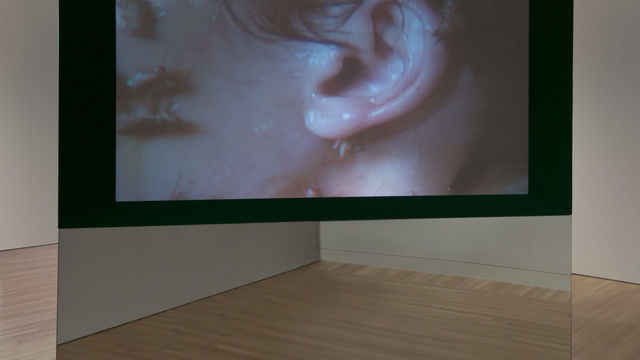
Judith Barry
Through her art and writing, Judith Barry examines and reimagines the spaces, subject positions, and material possibilities of art and life. As a pioneer of video art and, more broadly, as a pivotal artist, theorist, and critic, Barry has addressed questions of desire, subjectivity, social relations, and exile. Above all, her work demonstrates—and interrogates—the deep interrelationship between physical and discursive spaces, and their roles in the construction of identity.
Barry's subtle methods of investigation were already evident in one of her earliest videos, Casual Shopper (1980–81), which depicts the glittery seduction of a mall and the modes of consumption that such spaces produce. Barry, who studied architecture, trains the soft-focus camera on a woman strolling through synthetic spaces (mall, grocery store, and parking lot). Initially it seems that she is shopping for something specific, but as she wanders somewhat aimlessly, she appears to become trapped in a hallucinatory loop, her desires protracted and roving. Every so often she handles an object, but no one item stands out: birthday cards, pieces of fruit, and mannequins are treated with equal parts covetousness and indifference. Instances of sharper attention come when a handsome man with a mustache enters the scene. The two lock eyes, soap-opera style, but when the woman blinks or the camera shifts, he disappears and is thus revealed as a phantasm. The momentary suggestion of narrative falls flat, and the figures seem sapped of both inner life and fleshly existence.
Casual Shopper is transfixing, its rhythms familiar to anyone who has spent hours roaming similar gleaming, airless spaces. In between segments of instrumental background music, the woman occasionally speaks, uttering phrases like, "I'm just looking," "It's peaceful here," and "I feel relaxed." These statements seem to belong to the mall—in its intoxicating promise of fulfillment—as much as to the woman. Indeed, private fantasies and corporate consumer space become mutually constitutive: subjects are constructed, bodies and spirits are steered by the ideological space that they support (financially and otherwise) and inhabit.

Barry's video sculpture Imagination, dead imagine (1991) is similarly absorbing, but the glittering surfaces and specter-like characters of the earlier video are replaced here with intense physicality. The work is deliberately constructed as a cube in a reference to one of minimalism's favorite forms, and projected onto its ten-foot-high surfaces are a rotating series of oversize human heads, eyes blinking. In place of minimalism's cerebral tidiness, however, Barry foregrounds something pointedly abject: several times throughout the video, viscous materials—reminiscent of blood, urine, and other bodily fluids—are poured from above onto the heads, drenching them in slime. Borrowing its title from a story by Samuel Beckett about a couple trapped together in a room, Barry's work evokes a similarly clammy suffocation. The heads seem ensnared in space and at the mercy of a number of intangible, oppressive powers, both psychological and external.
In . . . Cairo stories (2010–11), part of an ongoing series titled Not Reconciled, Barry again looks at the ways in which space affects and alters lived experience. Here she examines how individuals are formed in relation to, and in reaction to, the politics of a nation-state and the structure of a city. Barry spent hundreds of hours interviewing Cairene women of many different classes and backgrounds about their relationship to the city.# With their permission, she wrote a series of short narratives based on this material and then filmed actors performing the scripts, half in Arabic, half in English, their faces filling the frame. The women repeatedly discuss the increasing demands to dress with the utmost modesty, and so it seems to follow that Barry has left everything below the shoulders unrepresented. As one explains, "The years go by, and it's like, all along, you're just hiding." In addition to its presentation as a group of plasma screens hung vertically, each accompanied by a still image of the woman interviewed in the segment, . . . Cairo stories has been projected onto public architectural sites (stairs, alleyways, walls). That this work can be shown on the fixtures of a city seems logical, since the narratives reveal the ways in which the women interviewed have negotiated—and come to understand—systems, values, and pressures of the transformed metropolis in which they are embedded. Between stories, the women stare out directly for a few seconds before fading to black and disappearing completely.
—Leora Morinis


